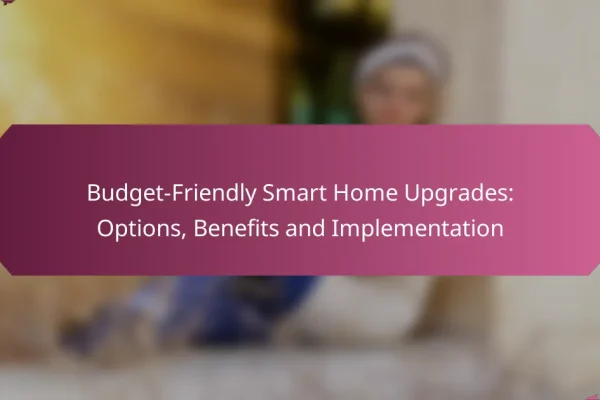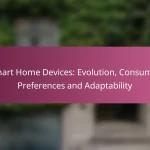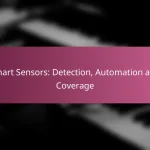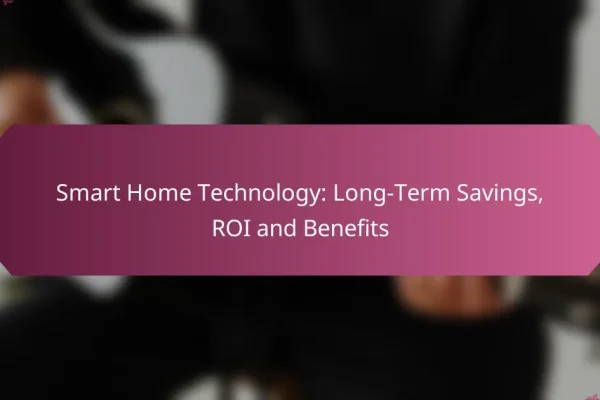What are the costs of smart home devices in the US?
The costs of smart home devices in the US can vary widely based on the type and brand. Generally, consumers can expect to spend anywhere from a few dozen to several hundred dollars per device, depending on features and capabilities.
Average pricing for smart speakers
Smart speakers typically range from around $30 to $300. Basic models, like the Amazon Echo Dot or Google Nest Mini, are often priced in the low $50 range, while premium options with advanced audio quality, such as the Apple HomePod, can exceed $300.
When choosing a smart speaker, consider factors like sound quality, compatibility with other devices, and whether you need built-in displays or additional features like smart home control.
Average pricing for smart thermostats
Smart thermostats generally cost between $100 and $250. Popular models like the Nest Learning Thermostat are often priced around $250, while simpler models may be available for as low as $100.
Investing in a smart thermostat can lead to energy savings, but be mindful of installation costs, which may add another $100 to $200 if you require professional assistance.
Average pricing for smart security systems
The cost of smart security systems can range from $200 to over $1,000, depending on the complexity and number of devices included. Basic packages with a few cameras and sensors may start around $200, while comprehensive systems with professional monitoring can exceed $1,000.
When evaluating smart security options, consider ongoing subscription fees for monitoring services, which can add to the total cost over time. Look for systems that offer flexibility in scaling up as your security needs grow.
How do smart home device costs compare?
Smart home device costs can vary significantly based on the type of device and its features. Generally, smart devices tend to have a higher upfront cost compared to their traditional counterparts, but they often provide long-term savings and enhanced functionality.
Smart speaker vs. traditional speakers
Smart speakers typically range from $50 to $300, depending on the brand and features. In contrast, traditional speakers can range from $20 to several thousand dollars, depending on quality and specifications. While traditional speakers may offer superior sound quality, smart speakers provide added functionality like voice control and integration with other smart devices.
When choosing between the two, consider your primary use. If you want a multi-functional device that can control your smart home, a smart speaker is a better choice. However, for audiophiles, investing in high-quality traditional speakers may be worthwhile.
Smart thermostat vs. manual thermostat
Smart thermostats generally cost between $100 and $300, while manual thermostats can be found for as low as $20. The higher price of smart thermostats is justified by their ability to learn your schedule, optimize energy usage, and be controlled remotely via smartphone apps.
Investing in a smart thermostat can lead to energy savings of around 10-20% on heating and cooling bills, making it a practical choice for homeowners looking to reduce costs over time. Ensure compatibility with your HVAC system before purchasing.
Smart security systems vs. traditional security systems
Smart security systems can range from $200 to over $1,000, while traditional systems may start at around $100 but often require additional monthly monitoring fees. Smart systems offer features like remote monitoring, alerts, and integration with other smart devices, which can enhance security and convenience.
When evaluating options, consider the total cost of ownership, including installation and monitoring fees. Smart systems may have higher upfront costs but can provide better long-term value through reduced monitoring fees and increased home security capabilities.
What factors influence smart home device pricing?
Smart home device pricing is influenced by several key factors including brand reputation, features, and installation costs. Understanding these elements can help consumers make informed purchasing decisions.
Brand reputation and quality
The brand of a smart home device often plays a significant role in its price. Well-established brands typically charge more due to their reputation for quality and reliability. Consumers may pay a premium for trusted names like Nest or Philips, which often come with better customer support and warranty options.
However, lesser-known brands can offer competitive pricing, sometimes with similar functionalities. It’s essential to research and read reviews to ensure that a lower price does not compromise quality.
Features and functionalities
The range of features and functionalities directly impacts the cost of smart home devices. Basic models may include simple automation and remote control, while advanced devices offer features like voice control, integration with other smart systems, and enhanced security options.
When evaluating devices, consider what features are necessary for your needs. For example, a smart thermostat with learning capabilities may cost more but can lead to energy savings in the long run.
Installation and setup costs
Installation and setup costs can vary widely depending on the complexity of the device and whether professional help is needed. Some smart home devices are designed for easy DIY installation, while others may require professional installation, which can add significantly to the overall expense.
When budgeting, factor in potential installation fees, which can range from low tens to hundreds of USD. Always check if the device includes installation services or if there are local regulations that might affect setup costs.
What are the long-term savings of smart home devices?
Smart home devices can lead to significant long-term savings through reduced energy consumption, lower utility bills, and potential discounts on insurance premiums. By optimizing energy use and enhancing home security, these devices not only improve convenience but also contribute to financial savings over time.
Energy savings from smart thermostats
Smart thermostats can adjust heating and cooling based on your habits, potentially reducing energy costs by 10-20%. By learning your schedule, these devices can lower temperatures when you’re away and raise them before you return, maximizing efficiency.
Consider models that offer features like geofencing, which adjusts settings based on your location. Additionally, many smart thermostats provide insights into your energy usage, helping you identify patterns and areas for further savings.
Cost savings from smart lighting
Switching to smart lighting can lead to energy savings of around 30-50% compared to traditional bulbs. Smart bulbs use LED technology and can be programmed to turn off when not needed, reducing electricity bills.
Utilize features like dimming and scheduling to further enhance savings. For example, setting lights to turn off automatically during the day can prevent unnecessary energy use. Look for smart lighting systems that integrate with home automation for seamless control.
Insurance discounts for smart security
Installing smart security systems can qualify homeowners for discounts on insurance premiums, often ranging from 5-20%. Insurance companies recognize that homes with advanced security measures are less likely to experience theft or damage.
When choosing a smart security system, consider features such as video surveillance, motion detectors, and smart locks. Ensure that the system is compatible with your insurance provider’s requirements to maximize potential savings.
What financing options are available for smart home devices?
Various financing options exist for smart home devices, allowing consumers to spread out the cost over time. Retailers, manufacturers, and government programs offer different solutions to make these technologies more accessible.
Payment plans from retailers
Many retailers provide payment plans that allow customers to purchase smart home devices without paying the full amount upfront. These plans often come with fixed monthly payments and may include interest or fees, so it’s essential to read the terms carefully.
Some retailers offer promotional financing options, like zero-interest plans for a limited time. This can be beneficial if you can pay off the device before the promotional period ends.
Credit options through manufacturers
Manufacturers of smart home devices often have their own financing programs, which may include credit cards specifically for their products. These cards can offer rewards or cash back on purchases, making them an attractive option for frequent buyers.
However, be cautious of high-interest rates that can apply if the balance is not paid in full each month. Always evaluate the total cost of financing before committing.
Government incentives for energy-efficient devices
In many regions, government programs provide incentives for purchasing energy-efficient smart home devices. These incentives can include tax credits, rebates, or grants that significantly reduce the overall cost.
To take advantage of these incentives, check local regulations and eligibility requirements. Some programs may require specific devices to qualify, so ensure your purchase aligns with these guidelines.
What are the emerging trends in smart home device pricing?
Smart home device pricing is increasingly influenced by technological advancements, consumer demand, and market competition. As more devices become interconnected, prices are showing a trend towards affordability, particularly for entry-level products.
Increased affordability of entry-level devices
Entry-level smart home devices are becoming more accessible, with prices often ranging from $20 to $100. This trend is driven by increased competition among manufacturers and the growing popularity of smart home technology.
For example, smart bulbs and basic smart plugs can be found at lower price points, making it easier for consumers to start building their smart home ecosystems without a significant financial commitment.
Bundling and subscription services
Many companies are now offering bundled packages that include multiple devices at a discounted rate. These bundles can range from $150 to $500, depending on the number and type of devices included.
Additionally, subscription services for monitoring and maintenance are becoming common, allowing users to pay a monthly fee for enhanced features and support. This model can help spread out costs over time, making smart home technology more manageable for budgets.
Impact of brand and ecosystem
The brand and ecosystem of smart home devices significantly affect pricing. Well-known brands often command higher prices due to perceived quality and reliability, while lesser-known brands may offer similar functionality at lower costs.
Choosing devices that are compatible with a specific ecosystem, such as Google Home or Amazon Alexa, can also influence pricing. Ecosystem compatibility often leads to better integration and user experience, which can justify higher costs.
Long-term savings through energy efficiency
Investing in smart home devices can lead to long-term savings, particularly through energy-efficient products. Devices like smart thermostats and energy monitoring plugs can reduce utility bills by optimizing energy usage.
While the initial investment may be higher, often ranging from $100 to $250 for smart thermostats, the potential savings on energy costs can offset the upfront expense over time. This makes smart home devices not only a convenience but also a financially savvy choice in the long run.





